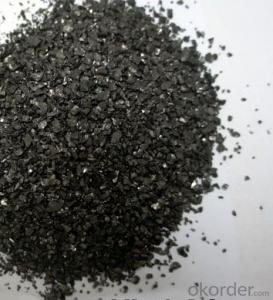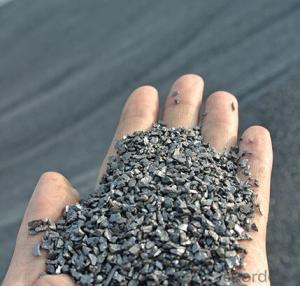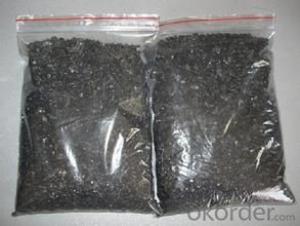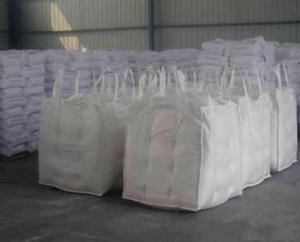Recarburizer 3-5mm 95% FC Carburant Carbon Additives
- Loading Port:
- Qingdao
- Payment Terms:
- TT OR LC
- Min Order Qty:
- 10 m.t.
- Supply Capability:
- 50000 m.t./month
OKorder Service Pledge
OKorder Financial Service
You Might Also Like
Specifications Of Recarburizer 95% FC
- High C content;
- Low S and N content;
- High abosorbility;
Recarburizer(Carburant, carbon additives) with high quality,0-20mm for metal casting foundry and steel plant, low nitrogen content and high carbon content, min 90% carbon content, at the same time as your requirements with no problem. The best media for adding carbon.
Technical Data Sheet of Recarburizer 95% FC
Fixed carbon | ≥ 95.5% |
Ash content | ≤ 5.0% |
Vol . Matter | ≤ 1.0% |
Sulphur content | ≤ 0.3% |
Moisture content | ≤ 0.3% |
Size | 0-20mm or as your requirement. |
Packing | - 25kg bag - One tone bags, Jumbo bag |
Delivery time | In 5-10 working days or depends on the order quantity |
Supply ability | 50000 Metric Ton Per Month |
Payment terms | L/C at sight or T/T |
Available Size: 0,1-4mm, 1-5mm, 3-8mm, 8-20mm (as per customers’ requirements)
Usage: widely used in casting foundry, steel-making, metallurgical Etc.
Applications of Recarburizer 95% FC
Mainly used in steel making in electrical stove, screening water, ship building sandblast to remove rust,producing carbon materials Etc.
Characteristics of Recarburizer 95% FC
- Particle size, porosity, absorption speed stable
- High degree of carbonize product, increase the original nuclear capability in the shape of liquid iron.
- Increased in the inoclation of nodular cast iron ball ink quantiyt, increase in th electric furnace iron graphit crystal nucleus.
- Excellent performance, stable.
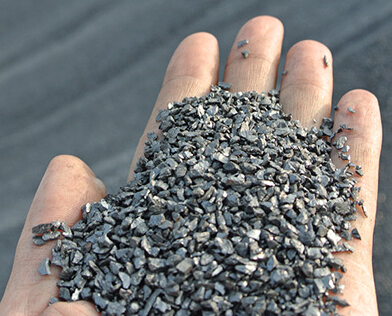

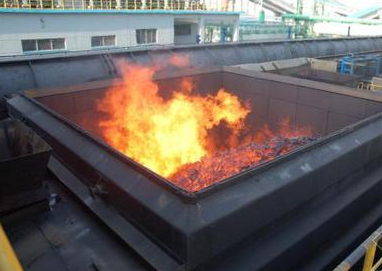

- Q:Emerald garden high carbon tempered metal
- 2.1 businessmen in the lower right corner. After 2.2, on an island below. Go and eat the merchant and bring him home. Kill the dragon. Be sure to hurry. The merchant fell off (I don't recommend it). You can also put a red dragon below killed off 2 Dragon eggs. Called red dragon, the businessman to eat, then at home, do not ignore it, he died, a businessman has come out. Get around the enemy base!
- Q:The main difference between steel and iron is the difference in carbon content
- The essential difference between steel and iron is that there is a difference in carbon content.1, steel, is a carbon content, mass percentage of 0.02% to 2.04% between the ferroalloy. The chemical composition of steel can have great changes, only the carbon steel is called carbon steel (carbon steel) or ordinary steel; in actual production, steel tend to use different with different alloy elements, such as manganese, nickel, vanadium and so on;2 iron is a chemical element. Its chemical symbol is Fe. It has an atomic number of 26. It is the most common metal. It is a kind of transition metal. A metal element with a second highest crustal content.Extension of knowledge point:Iron into pig iron and wrought iron. Wrought iron, steel and cast iron is an alloy of iron and carbon with the carbon content difference. Generally less than 0.2% carbon content that wrought iron or iron, the content of 0.2-1.7% in the steel, is iron content of more than 1.7%. Soft wrought iron, good plasticity, easy deformation, strength and hardness were lower, not widely used; iron carbon, hard and brittle, almost no plastic; steel pig iron and wrought iron with two kinds of advantages, widely used for human.
- Q:How does carbon impact the global water cycle?
- Carbon can have a significant impact on the global water cycle through various processes. One major way carbon affects the water cycle is through the process of photosynthesis. Plants and trees take in carbon dioxide from the atmosphere during photosynthesis and convert it into oxygen and glucose. This process not only helps in the carbon cycle but also plays a crucial role in the water cycle. During photosynthesis, plants release water vapor into the atmosphere through tiny pores called stomata. This water vapor contributes to the overall humidity in the atmosphere, leading to an increase in cloud formation. Clouds, in turn, play a crucial role in the water cycle as they contain condensed water droplets that eventually fall as precipitation. Additionally, carbon dioxide is a greenhouse gas that contributes to global warming and climate change. As the Earth's temperature rises due to increased levels of carbon dioxide, the water cycle is also affected. Warmer temperatures can lead to increased evaporation rates, causing more water to evaporate from oceans, rivers, and lakes. This excess moisture in the atmosphere can result in more intense rainfall events, leading to floods and other extreme weather events. Furthermore, carbon dioxide can impact the acidity of water bodies. When carbon dioxide dissolves in water, it forms carbonic acid, which can lower the pH of the water. This process, known as ocean acidification, can have detrimental effects on marine life, particularly organisms that rely on calcium carbonate for their shells and skeletons. These impacts can disrupt the balance of ecosystems and have long-term consequences for the health and functioning of the global water cycle. In summary, carbon has a profound impact on the global water cycle through processes such as photosynthesis, greenhouse gas emissions, and ocean acidification. Understanding these interactions is crucial for managing the effects of carbon on the environment and ensuring the sustainability of the water cycle.
- Q:How does carbon dioxide affect the pH of soil?
- Carbon dioxide can affect the pH of soil through a process called carbonation. When carbon dioxide dissolves in water, it forms carbonic acid (H2CO3), which is a weak acid. When this acid is present in soil, it can react with certain minerals and compounds, such as limestone or calcium carbonate, found in the soil, resulting in their dissolution. This process releases positively charged ions, such as calcium (Ca2+) or magnesium (Mg2+), into the soil solution, which can increase the soil's alkalinity or raise the pH. Additionally, the presence of carbonic acid can also increase the availability of certain nutrients in the soil. For example, it can enhance the solubility of phosphorus, making it more accessible for plants to uptake. This can lead to an increase in soil fertility. However, it is important to note that the effect of carbon dioxide on soil pH can vary depending on different factors, such as the concentration of carbon dioxide, soil type, and the presence of buffering agents. In some cases, the buffering capacity of the soil can limit the impact of carbonic acid on pH changes. Therefore, while carbon dioxide can influence soil pH, it is just one factor among many that can affect the overall acidity or alkalinity of soil.
- Q:Why vegetarianism can reduce carbon emissions?
- This specific or calculated, and if you have done ISO14064, you should know that every year will be the carbon emissions statistics, the general is your year of all activities in accordance with the corresponding CO2 coefficients into CO2 equivalent;If you eat according to statistics, that is to calculate what you eat, how much CO2 is needed to produce;
- Q:Is there a line cutting of carbon fibers?
- Your question is not clear. Do carbon fibers need to be cut with wire? Are carbon fiber composites? What type? In general, carbon fiber reinforced composites can not be cut by wire. They can be cut by ultrasonic and water cut
- Q:Rod box material, there is a kind of material called carbon fiber, who knows this material is good?
- This material is good. Carbon fiber is a new kind of fiber material with high strength and high modulus of carbon content of more than 95%. It is a flaky graphite, microcrystalline and other organic fibers stacked along the axial direction of the fiber, obtained by carbonization and graphitization of microcrystalline graphite material. Carbon fiber "an hand in a velvet glove lighter than aluminum," the quality, but the strength is higher than that of steel, and has the characteristics of corrosion resistance, high modulus, in the national defense and civilian areas are important materials. It has not only the intrinsic characteristics of carbon materials, but also the softness and processability of textile fibers. It is a new generation of reinforced fiber.
- Q:What are the effects of carbon emissions on the Earth's temperature?
- Carbon emissions contribute to the greenhouse effect, trapping heat in the Earth's atmosphere and leading to an increase in global temperatures. This phenomenon, known as global warming, has numerous adverse effects such as melting ice caps, rising sea levels, extreme weather events, and disrupted ecosystems.
- Q:Carbon injection molding machine heating several degrees
- Polycarbonate (PC) is a colorless and transparent engineering plastics, the impact strength is high, the use of a wide temperature range, good creep resistance, electrical insulation and dimensional stability; the disadvantage is sensitive to the gap, environmental stress cracking resistance, with metal insert molding products is difficult.Polycarbonate, English name Polycarbonate, referred to as PC. PC is a kind of amorphous, odorless, non-toxic, highly transparent colorless or slightly yellow thermoplastic engineering plastics, has excellent physical and mechanical properties, especially excellent shock resistance, tensile strength, bending strength, compressive strength and high creep; small size stability; has good heat resistance and low temperature resistance and with mechanical properties, stable in a wide range of temperature dimensional stability, electrical properties and flame retardant properties, can be used for a long time at -60~120 deg.c; no obvious melting point, molten at 220-230 DEG C; because the molecular chain rigidity, resin melt viscosity; low water absorption, low shrinkage, size high precision, good dimensional stability, permeability of films is small; self extinguishing materials; stable to light, but not UV resistance, good weather resistance; oil resistance, acid and alkali resistance, non oxidizing acids and amines, ketones, solution Chlorinated hydrocarbons and aromatic solvents are prone to hydrolysis and cracking in water for a long time. The disadvantage is that they are prone to stress cracking due to poor fatigue resistance, poor solvent resistance and poor wear resistance.
- Q:How does carbon affect the properties of steel?
- Carbon is a crucial element in the production of steel and plays a significant role in determining its properties. The amount of carbon present in steel has a direct impact on its hardness, strength, and overall performance. By adding carbon to iron, the base metal of steel, it becomes significantly stronger and more durable. This is because the carbon atoms are able to occupy the spaces between iron atoms, preventing the metal from sliding or deforming easily. The higher the carbon content, the harder and stronger the steel becomes. Moreover, carbon also influences the steel's ability to be heat treated and its response to various manufacturing processes. When steel is heated and rapidly cooled, a process known as quenching, the presence of carbon allows for the formation of harder and more brittle structures, such as martensite. On the other hand, lower carbon content allows for the formation of softer and more ductile structures. In addition to its impact on strength and hardness, carbon also affects the steel's corrosion resistance. Higher carbon content can lead to reduced corrosion resistance, making the steel more susceptible to rust and other forms of degradation. This is why stainless steel, which contains a higher amount of chromium and low carbon content, is often chosen for applications where corrosion resistance is crucial. To summarize, carbon greatly influences the properties of steel. It enhances its strength and hardness, allows for heat treatment and response to manufacturing processes, and affects its corrosion resistance. The careful control of carbon content in steel is vital in order to achieve the desired properties for specific applications.
1. Manufacturer Overview |
|
|---|---|
| Location | |
| Year Established | |
| Annual Output Value | |
| Main Markets | |
| Company Certifications | |
2. Manufacturer Certificates |
|
|---|---|
| a) Certification Name | |
| Range | |
| Reference | |
| Validity Period | |
3. Manufacturer Capability |
|
|---|---|
| a)Trade Capacity | |
| Nearest Port | |
| Export Percentage | |
| No.of Employees in Trade Department | |
| Language Spoken: | |
| b)Factory Information | |
| Factory Size: | |
| No. of Production Lines | |
| Contract Manufacturing | |
| Product Price Range | |
Send your message to us
Recarburizer 3-5mm 95% FC Carburant Carbon Additives
- Loading Port:
- Qingdao
- Payment Terms:
- TT OR LC
- Min Order Qty:
- 10 m.t.
- Supply Capability:
- 50000 m.t./month
OKorder Service Pledge
OKorder Financial Service
Similar products
New products
Hot products
Related keywords
